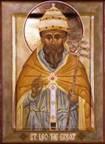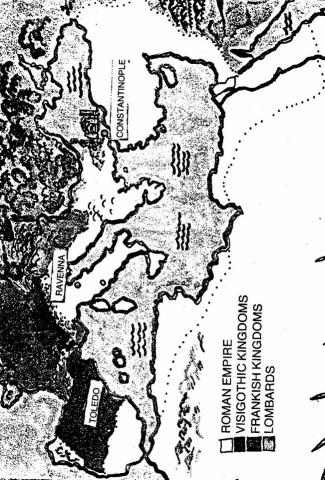Byzantine Age: Fall of Rome
UNIT 8: THE BYZANTINE AGE
Objective: Students should be able to discuss the reasons for, importance of, and changes caused by the fall of Rome and the rise of Islam, the beliefs of Moslems today, the glory of the Byzantine Empire under Justinian, and the rise of the Holy Roman Empire in the West, and the role of Charlemagne in the changing of the creed.
WEEK 1: FALL OF ROME
Barbarian Invasions:
Actually, the beginning of the end for old Rome was the Emperor Constantine. He founded a new city, named for himself, Constantinople, and moved the capital of the Roman Empire to his new city, far to the east of Rome. The new city was Christian from the start, full of churches. Councils were held there.
Far to the west, in Rome, things were not going so well. Many wild tribes lived to the north. They were fierce warriors and knew nothing of Christianity or the great Roman cities and culture. They were called “barbarians” by the Romans because they didn’t even speak Latin or Greek. They lived in little villages and tribes. But, they wanted more and more land. Have a map handy to trace the events that follow:
 Unfortunately, Theodosius the Great was the last Emperor to rule both the eastern and western halves of the empire. His two sons, Arcadius in the East and Honorius in the West were incompetent and weak. The barbarians saw their opportunity. First came the Visigoths out of Germany under King Alaric; they marched into Rome and looted everything in sight. Alaric died shortly thereafter, but many Goths remained in Italy and became Christians. Another of these tribes was called the Huns; their chief was Attila the Hun. Attila moved his army down Italy toward Rome itself. They burned and destroyed everything in their way. Finally they were at the gates of Rome. The bishop of Rome in that day was named Leo I (the first). Leo means “lion” but this Leo was not a soldier or a fighting man. But he wanted to save his city and his people. He went out the gates of the city, dressed in his gorgeous robes, with all the bishops and priests. He carried no shield or sword or spear. Would Attila and his men slaughter them like lambs before the wolves? Attila and Leo met outside the walls of Rome. Then, Attila and his army turned around and left Italy – marched away without even entering the city or killing anyone. Leo may not have been a fighting man, but he had the courage of a lion! The Huns moved back to the Balkan area and became part of the state of Bulgaria.
Unfortunately, Theodosius the Great was the last Emperor to rule both the eastern and western halves of the empire. His two sons, Arcadius in the East and Honorius in the West were incompetent and weak. The barbarians saw their opportunity. First came the Visigoths out of Germany under King Alaric; they marched into Rome and looted everything in sight. Alaric died shortly thereafter, but many Goths remained in Italy and became Christians. Another of these tribes was called the Huns; their chief was Attila the Hun. Attila moved his army down Italy toward Rome itself. They burned and destroyed everything in their way. Finally they were at the gates of Rome. The bishop of Rome in that day was named Leo I (the first). Leo means “lion” but this Leo was not a soldier or a fighting man. But he wanted to save his city and his people. He went out the gates of the city, dressed in his gorgeous robes, with all the bishops and priests. He carried no shield or sword or spear. Would Attila and his men slaughter them like lambs before the wolves? Attila and Leo met outside the walls of Rome. Then, Attila and his army turned around and left Italy – marched away without even entering the city or killing anyone. Leo may not have been a fighting man, but he had the courage of a lion! The Huns moved back to the Balkan area and became part of the state of Bulgaria.
Soon after, the Vandals, another wild tribe, captured northern Africa. A man named Augustine was Bishop of the city of Hippo at this time. Augustine had been a great teacher and writer of the western Church. His “Confessions” and “City of God” are read to this day. But, Augustine was old and ill and died while the Vandals were attacking the city. They sailed up the Tiber River to Rome. They captured the city and stole all its treasures! The Angles and Saxons took Britain; it is “Angle-land” to this day. Then another tribe called the Teutons divided up the empire. Just like Humpty Dumpty, Rome had a great fall – broken into many pieces by the barbarian tribes and never to be put back together again. Each tribe had its different customs and wanted to rule its land in its own way. The last Emperor was named Romulus Augustulus. Old Rome was beaten. It was the year 476 AD.
The Dark Ages:
Review with the students their probably extensive knowledge of the Dark Ages in the West, even if they think they know nothing. Show pictures from any history book. It was a feudal time, of small lords ruling from their castles over fiefdoms full of poverty-stricken serfs. Think of King Arthur, of knights and squires and pages. But, while this time may seem romantic in the movies, castles were drafty and cold, there was no more plumbing or running (as had been the case under Rome), people were dirty and smelly, hardly anyone could read. Why is it called the Dark Ages in the West?
Rise of the Papacy:
The common language, coinage, communications, mail service – all disappeared in the West. Each small area became a tribal state. Only in the Church was the Roman culture preserved; the monks wrote the Scriptures in Latin and taught in monasteries. The Bishop of Rome, the only Patriarch in the West, became the only central figure in a sea of small lordships. Under Leo the Great and Gregory I, the Bishops of Rome became known in the west as Pope, or Father. With a vacuum in leadership, the Pope was recognized as the successor of St. Peter and of the Roman Caesars as well. Small kings and lords turned to Rome for decisions, not just spiritual, but temporal as well. The Pope was a symbol of stability and authority in an age of darkness.
This movement in papal history is personified in Gregory the Great. Gregory was a politician, who left politics, gave all his possessions to the poor, and became a monk. He rose to become Pope of Rome. He made official the church music known today as Gregorian chant. But, in the political realm, unlike bishops in the old Rome who ruled spiritually under the political leadership of the Emperor, Gregory managed the estates of the Church to earn money, raised an army to drive the barbarian Lombards out of Rome, and insisted that the rulers of Spain and France swear loyalty to him.
The Glory of the Byzantine Empire:
About 50 years after the fall of Rome, Justinian became emperor in the East. In this day, Constantinople was the greatest city in the world. The waters around the city were filled with boats; it had high walls to protect it from enemies. People came from all over the world to see the beautiful city and study in its many famous schools and worship in its churches. Justinian saw his city as the Second Rome, greater and finer than Rome ever was.
Justinian also began to collect all the laws of his land. Until this time, each city and state had its own rules and judges. Justinian sent wise lawyers throughout the land and gathered all these laws. They chose the best from each city and wrote a law that would be true throughout the land, the Code of Justinian.
Justinian wanted to take back the lands of the west that had been lost to the barbarians. He first sent his mighty army against the Vandals in North Africa. He took back northern Africa and went from there to Italy and southern Spain. His empire went around the Mediterranean, although he never retook France or England. Review the map on the next page to see the extent of Justinian’s empire. Note that his capital of Italy was not Rome, but Ravenna – closer to Constantinople, perhaps, but a political move not ignored by the Bishops of Rome. How was his plan to reunite the West and East and re-form the Roman Empire stopped prematurely? The Plague of Justinian struck the empire in 541 AD at the peak of its conquest. This plague, caused by the same bacterium that struck later in Europe as the Black Death, killed thousands each day in all parts of the Byzantine Empire. Justinian himself contracted and survived the disease, but his armies and food supply were weakened and enemies quickly moved in to reconquer lands he had annexed.
a political move not ignored by the Bishops of Rome. How was his plan to reunite the West and East and re-form the Roman Empire stopped prematurely? The Plague of Justinian struck the empire in 541 AD at the peak of its conquest. This plague, caused by the same bacterium that struck later in Europe as the Black Death, killed thousands each day in all parts of the Byzantine Empire. Justinian himself contracted and survived the disease, but his armies and food supply were weakened and enemies quickly moved in to reconquer lands he had annexed.
How was his plan to reunite the West and East and reform the Roman Empire stopped prematurely? The Plague of Justinian struck the empire in 541 AD at the peak of its conquest. This plague, caused by the same bacterium that struck later in Europe as the Black Death, killed thousands each day in all parts of the Byzantine Empire. Justinian himself contracted and survived the disease, but his armies and food supply was weakened and enemies quickly moved in to reconquer lands he had annexed.
Justinian also had architects throughout his empire build beautiful churches. The greatest of these was Haggia Sophia, the Church of the Holy Wisdom, in Constantinople. This magnificent church is topped with a huge dome. Artists painted beautiful icons and worked mosaics of tiny pieces of stone and glass. A mosaic could cover the entire wall of a church or monastery. Frescoes were painted in wet plaster right onto the walls of churches. Goldsmiths made beautiful jewelry set with precious stones. The Byzantine Empire became the art and cultural capital of the world.
Quiz Questions:
- Identify these people: Theodosius the Great, Attila, Alaric, and Gregory the Great.
- Identify these places on a map: Gaul, Balkan peninsula, Constantinople, Rome
- Trace on a map the major invasions and conquests of the barbarian tribes.
- List at least 5 characteristics of Western culture during the Dark Ages.
